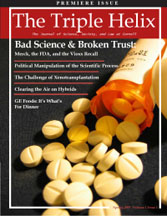Cornell Nobel laureates address science, storytelling and pseudoscience in undergraduate conference

Nobel Prize winners do not commonly associate themselves with scientific frauds. But such frauds became forceful examples as two Cornell University Nobel laureates spoke at the first conference of the Triple Helix, an undergraduate-run organization that publishes a journal of science, society, business, ethics and law. It was founded by Cornell students last year and now has chapters on 12 other campuses, including Yale, Dartmouth and Brown universities.
The conference, held Nov. 19 on a cool Saturday morning in Uris Hall auditorium, celebrated the release of the first national issue of the journal, the first and only national undergraduate print journal of its kind in the United States. Nobel laureate Roald Hoffmann, the Frank H.T. Rhodes Professor of Humane Letters at Cornell, addressed the intertwined relationship between science and ethics and the strong element of storytelling in narrating science.
"Human beings must interpret the data, and yes, they must tell a story," said Hoffmann, who argued that ethics is deeply ingrained in the practice of science. As an example, he talked about the mental process involved in reading a scientific publication. "It is an ethically productive action," he said. "It is a cycle of trust and mistrust as issues are being negotiated."
Hoffmann said that scientists today either believe their work is ethically neutral or inherently ethical. "'I just cloned the thing. Now let others worry about what to do,'" said Hoffmann, mocking these types of thinking. Moreover, he criticized scientists who create tools without foresight of their implications and deemed such action as "deeply and morally incomplete."
Robert C. Richardson, the Floyd Newman Professor of Physics and vice provost for research at Cornell, gave a lighthearted talk on gadgets based on pseudoscience, starting off with an anecdote about 19th-century cures based on "animal electricity," a misuse of the discovery of the electrical basis of nerve impulses made by Italian scientist Luigi Galvani. Noting such gadgets as cell phone radiation shields and biomagnets advertised in mail-order catalogs, Richardson pointed out that many modern gadgets lay similar claims to cure all kinds of ailments, from hypertension and sweating to diabetes and cancer.
"These gadgets borrowed the word of science," said Richardson, who shared many advertisements that were accompanied by spotty scientific proof. Moreover, he claimed, such fraud usually claims exorbitant benefits, uses catchy scientific phrases, depends on "new science" and inexplicably violates the laws of thermodynamics.
The discussion on connections among science, society and law reflect the mandates of the Triple Helix, a nonprofit organization that aims to bridge gaps among different fields of study.
"Our goal in this conference was to stay true to the mission of the Triple Helix," said Kevin Hwang '07, founder of the organization. "We wanted to bring back our core values."
Alex Kwan is a writer intern with the Cornell News Service.
Media Contact
Get Cornell news delivered right to your inbox.
Subscribe